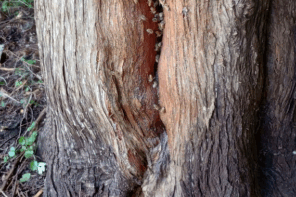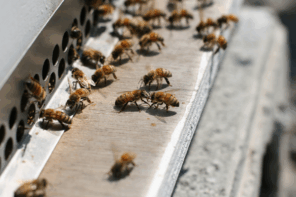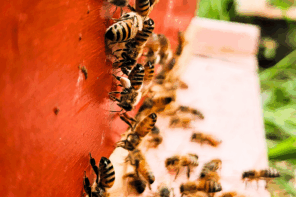 Queen Development and Traits
Queen Development and Traits
Clarence Collison
One of the most widely used biomarkers of queen health is brood pattern—defined as the shape left by the egg-laying behavior of the queen. Because the reproductive capacity of the queen is fundamental for colony growth, the homogeneity of capped brood in a colony is often used as an indication of the quality of the queen (e.g., more continuous brood indicates a better queen) (López-Uribe and Simone-Finstrom 2019).
Failure of the queen is often identified as a leading cause of honey bee colony mortality. However, the factors that can contribute to “queen failure” are poorly defined and often misunderstood. Lee et al. (2019) studied one specific sign attributed to queen failure: poor brood pattern. In 2016 and 2017, they identified pairs of colonies with “good” and “poor” brood patterns in commercial beekeeping operations and used standard metrics to assess queen and colony health. They found no queen quality measures reliably associated with poor-brood colonies. In the second year (2017), they exchanged queens between colony pairs (n=21): a queen from a poor-brood colony was introduced into a good-brood colony and vice versa. They observed that brood patterns of queens originally from poor-brood patterns significantly improved after placement into a good-brood colony after 21 days, suggesting factors other than the queen contributed to brood pattern. Their study challenges the notion that brood pattern alone is sufficient to judge queen quality. Their results emphasize the challenges in determining the root source for problems related to the queen when assessing honey bee colony health. This study will challenge the widespread use of brood patterns as a metric of queen health and raises questions about how colony phenotype influences queen health and reproductive metrics (López-Uribe and Simone-Finstrom 2019).
In honey bee colonies, reproduction is monopolized by the queen while her daughter workers are facultatively sterile. Caste determination is a consequence of environmental conditions during development, during which female larvae may become either queens or workers depending on their larval diet. This bi-potency introduces significant variation in the reproductive potential of queen bees, with queens raised from young worker larvae exhibiting high reproductive potential and queens raised from older worker larvae exhibiting lower reproductive potential. Tarpy et al. (2011) verified that low quality queens are indeed produced from older worker larvae, as measured morphometrically (e.g. body size) and by stored sperm counts. They also showed, for the first time, that low quality queens mate with significantly fewer males, which significantly influences the resultant intra-colony genetic diversity of the worker force of their future colonies.
The age of the brood used for rearing queens has a major impact on the quality of the resulting queens. The best are queens reared from eggs. The aim of the experiment was to investigate whether the age of the eggs affects their acceptance by the rearing colonies. In four series, eggs at the age of zero to 18, 24-42 and 48-66 hours were introduced to five colonies. All colonies in the first and third series had open brood and were one day without queens. The second and fourth series had no open brood and were 10 days without queens. Out of all the 720 introduced eggs, the bees accepted 44.4% for queen rearing. No significant differences were detected between the total number of eggs accepted by the colonies with an open brood – one day after the queens had been removed (43.6%) and colonies without open brood – ten days after the queens had been removed (45.3%). However, significant differences were detected between the acceptance of eggs of different ages. The age of the eggs did not significantly influence their acceptance by rearing colonies with open brood – one day after the queens had been removed. However, the bees significantly accepted the lowest percentage of eggs (25%) after the youngest eggs, zero to 18 holds were introduced, and the bees accepted the highest percentage of eggs (64.2%) after the oldest, 48-66 hours old were introduced into colonies without open brood – ten days after queen removal (Gabka et al. 2011).
The research was conducted at the apiary of the Faculty of Agriculture, Zanjan University in Zanjan, Iran. Queens were reared in 24 Apis mellifera meda honey bee rearing colonies. The colonies were assigned to four grafting larvae age groups: one day old larvae, two day old larvae, three day old larvae and the last group reared emergency queen cells. The groups were divided into the two feeding groups: fed additionally and no feed. The effects of the age of the grafted larvae and the effects of supplemental feeding on nine morphological characteristics of queens were measured. The results showed that the age of the larvae significantly affected the morphological characteristics of reared queens, and thus, their quality. Queens reared from one day old larvae were of the highest quality. These queens were significantly heavier (158.83 mg) and had significantly larger spermatheca (0.99 mm3) than queens reared from larvae two and three days old. Queens from emergency queen cells were of lower quality than queens reared from one day old larvae. However, queens from emergency queen cells were of higher quality than queens reared from three day old larvae. The supplemental feeding significantly increased most morphological characteristics of the reared queens. The different ages of the larvae did not significantly affect the wing length nor did supplemental feeding affect the wing length (Mahbobi et al. 2012).

Slobodan et al. (2020) investigated the influence of various diets on the quality of queens. Colonies intended for queen cell production were assigned to four groups fed on (1) sugar-only, (2) mix of sugar, honey and fresh pollen, (3) sugar and pollen substitute (FeedBee®) and (4) natural sources. In addition, a fifth group had queen cells obtained naturally, by swarming. Sugar-only diet exerted a significant stimulating effect on the acceptance of queen cells and the weight of newly emerged queens, not affecting mated queens. Among mated queens, those raised by bees fed on the mix of sugar, honey and fresh pollen had significantly larger numbers of ovarioles in comparison with all the others. Their weight was significantly higher than that of the queens from groups given FeedBee® and swarming queens. Compared to the latter, they had significantly wider spermatheca. Given the parameters monitored, FeedBee® proved not to be advantageous for queens.
The honey bee queen, mother of all individuals in the colony, determines the inherited characteristics of the colony. Periodic replacement of old queens by a young and high quality one is an important management practice in the commercial beekeeping industry. Virgin queens’ introduction is independent of weight at emergence and genetic relatedness of their receptor worker bees. A total of 243 queens from three genotypes of Apis mellifera lamarckii, A. m. carnica and A. m. ligustica (81 queens of each genotype) were weighed at emergence and allocated into three groups as: light (110-130 mg) 45 queens, medium (140-160 mg) 68 queens, heavy (over 160 mg) 130 queens and introduced into mating nuclei. The weight at emergence was significantly affecting the introduction success. Queens with heavy weight at emergence had the highest number of introduction successes with 103 queens (79.23%). The medium weight at emergence of virgin queens has the highest number of failed queens with 26 queens (38.23%). The number of drone laying queens was approximately the same for all groups. Genotype of introduced queens was highly significant in influencing their acceptance rate. Introducing A. m. carnica and A. m. lamarckii to nuclei with workers from the same genotype had the highest introduction success (Masry et al. 2015).
Worker honey bees in queenless colonies constructed emergency queen cells on the periphery of the brood area on a comb when ambient temperatures were high, and in the center of the comb when ambient temperatures were low. Queen cells in the center of the hive’s broodnest were maintained at significantly higher temperatures and had a greater chance of emerging than queen cells located on the periphery. Temperatures around cells from which queens emerged fluctuated by <10°C, even though ambient temperatures had a range of >25°C. The average temperatures around cells from which queens emerged were 32.3–34.9°C (90.1-94.8°F); lower averages occurred during the Winter trials. Queens took an average of 15.4–17.4 days to develop. The central brood area of a colony had a significantly higher temperature with a narrower range than around any queen cell (DeGrandi-Hoffman et al. 1993).
The productivity and survival of honey bee colonies depend on queen bee health. Colony-level neonicotinoid exposure has negative effects on reproductive fitness of honey bee queens. However, it is unclear if the observed effects are a direct outcome of neonicotinoid toxicity or result from suboptimal care of developing queens by exposed workers. The aim of this study was to evaluate larval survival, reproductive fitness, and histopathology of honey bee queens exposed to incremental doses (0, 5, 50 ng) of the neonicotinoid thiamethoxam (THI) applied directly to individual late larvae (seven days post-oviposition) of queens. The 5-ng dose represents a calculated high environmental level of exposure for honey bee queen larvae. Morphometric evaluation revealed that the total area of mandibular gland epithelium in queens exposed to five and 50 ng THI was reduced by 14% and 25%, respectively. Decreased mandibular gland size may alter pheromone production, which could in part explain previously observed negative effects of THI on the reproductive fitness of queens. They also found that late larval exposure to THI reduced larval and pupal survival and decreased sperm viability in mated queens. These changes may interfere with queen development and reproductive longevity (Kozii et al. 2021).
Rearing techniques are important in producing high quality queens. Queen cell cup size may affect the acceptance rate of grafted larvae and determine the size of the queen, which in turn may influence the quality of the colonies. The present study compared the effect of different queen cell cup sizes (8.0 vs 9.0 mm diameter) on morphometric characteristics of queen honey bees. Sixty-five larvae were grafted in each treatment. Larvae transfer was carried out five times, in June and August 2019. Head, thorax and abdomen width of the newly emerged queens were measured using an electronic calliper, and the weight of each of the three segments was recorded using a precision scale. All morphometric traits measured on the accepted larvae were significantly higher in queens raised in larger cell cups, except for head width. Principal Component Analysis on morphometric traits shows higher values on PC1 (58.4% of explained variance) for queens raised in larger cell cups. Highest loadings were found for variables related to weight of the three parts. Among the many factors affecting queen’s quality, cell cup size seems to have a positive effect on queens’ body parts weights. Increasing the standard diameter of conventional cell cups allows rearing heavier and larger honey bee queens. The grafting period affects morphometric parameters, with higher size and body weight in the last week of June (Mattiello et al. 2022).
During mating flights honey bee queens copulate with about 10-20 drones. A possible explanation why polyandry (females having more than one male mate) has evolved in honey bees is that colonies from single-mated queens are inferior to those from polyandrous queens. It was investigated whether the performance of full and small test colonies would be lower if workers were from queens artificially inseminated with semen from one drone opposed to equal amounts of mixed semen from several drones. Six colonies with queens inseminated with 1 μl semen of a single drone, each of a different father colony, were compared with six colonies where queens had been inseminated with mixed semen of six drones from the same colonies. Colonies with single paternity showed at times lower drone brood production, lower pollen and honey storage, and fewer queen cells, while deviations in the opposite direction were small and not significant. Bee numbers and amount of sealed worker brood were not affected. Three short-time tests were performed involving a total of 75 small bee colonies kept in Kirchhainer mating boxes. Comb building, storage of honey and pollen, and brood rearing were lower in the colonies containing workers of only one patriline. The results support that a group advantage exists in performance of honey bee workers with mixed paternity, which might have promoted the evolution of polyandry in honey bee queens (Fuchs and Schade 1994).
Extreme temperature exposure can reduce stored sperm viability within queen honey bees; however, little is known about how thermal stress may directly impact queen performance or other maternal quality metrics. Here, in a blind field trial, McAfee et al. 2021 recorded laying pattern, queen mass and average callow worker mass before and after exposing queens to a cold temperature (4°C (39.2°F), two hours), hot temperature (42°C (107.6°F), two hours) and hive temperature (33°C (91.4°F), control). They measured sperm viability at experiment termination and investigated potential vertical effects of maternal temperature stress on embryos using proteomics. They found that cold stress, but not heat stress, reduced stored sperm viability; however, found no significant effect of temperature stress on any other recorded metrics (queen mass, average callow worker mass, laying patterns, the egg proteome and queen spermathecal fluid proteome). Previously determined candidate heat and cold stress biomarkers were not differentially expressed in stressed queens, indicating that these markers only have short-term post-stress diagnostic utility. Combined with variable sperm viability responses to temperature stress reported in different studies, these data also suggest that there is substantial variation in temperature tolerance, with respect to impacts on fertility, amongst queens (McAfee et al. 2021).
References
DeGrandi-Hoffman, G., M. Spivak, and J.H. Martin 1993. Role of thermoregulation by nestmates on the development time of honey bee (Hymenoptera: Apidae) queens. Ann. Entomol. Soc. Am. 86: 165-172.
Fuchs, S. and V. Schade 1994. Lower performance in honey bee colonies of uniform paternity. Apidologie 25: 155-168.
Gabka, J., M. Ochnio, Z. Kamiński and B. Madras-Majewska 2011. Effect of age of eggs used for rearing honey bee queens on the number of received queen cells. J. Apic. Sci. 55: 47-51.
Kozii, I.V., S. Barnsley, M.C. Bezerra da Silva, S.C. Wood, C.D. Klein, I.M. de Mattos, M.W. Zabrodski, R. de C.M. Silva, C.I.O Fabela, L. Guillemin, I. Dvylyuk, M. C.O. Ferrari, and E. Simko 2021. Reproductive fitness of honey bee queens exposed to thiamethoxam during development. Vet. Pathol. 58: 1107-1118.
Lee, K.V., M. Goblirsch, E. McDermott, D.R. Tarpy and M. Spivak 2019. Is the brood pattern within a honey bee colony a reliable indicator of queen quality? Insects 10,12; doi:10.3390/insects10010012
López-Uribe, M.M. and M. Simone-Finstrom 2019. Special issue: honey bee research in the U.S.: current state and solutions to beekeeping problems. Insects 10,22; doi:10.3390/insects1001022
Mahbobi, A., M. Farshineh-Adl, J. Woyke and S. Abbasi 2012. Effects of the age of grafted larvae and the effects of supplemental feeding on some morphological characteristics of Iranian queen honey bees (Apis mellifera meda Skorikov, 1929). J. Agric. Sci. 56: 93-98.
Masry, S.H.D., T.E. Abd El-Wahab and N.M. Hassona 2015. Origin, weight at emergence of virgin honey bee queens and its effect on acceptance during introduction. Acad. J. Entomol. 8: 174-182.
Mattiello, S., R. Rizzi, M. Cattaneo, P.A. Martino, and M. Mortarino 2022. Effect of queen cell size on morphometric characteristics of queen honey bees (Apis mellifera ligustica). Ital. Anim. Sci. 21: 532-538.
McAfee, A., D.R. Tarpy and L.J. Foster 2021. Queen honey bees exhibit variable resilience to temperature stress. PLoS ONE 16(8): e0255381.
Slobodan, D., S. Jevrosima, A. Nevenka, G. Uros, D. Nebojsa, M. Mica, and S. Zoran 2020. The effect of diet types on some quality characteristics of artificially reared Apis mellifera queens. J. Apic. Res. 59: 115-123.
Tarpy, D.R., J.J. Keller, J.R. Caren and D.A. Delaney 2011. Experimentally induced variation in the physical reproductive potential and mating success in honey bee queens. Insect. Soc. 58: 569-574.
Clarence Collison is an Emeritus Professor of Entomology and Department Head Emeritus of Entomology and Plant Pathology at Mississippi State University, Mississippi State, MS.









